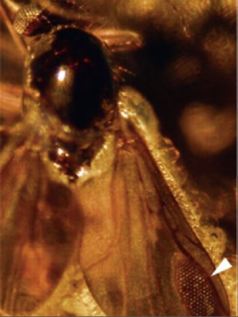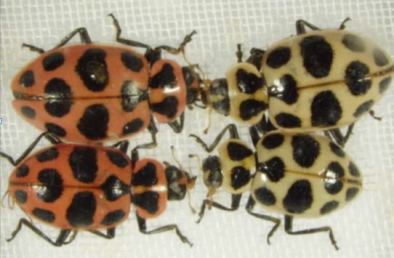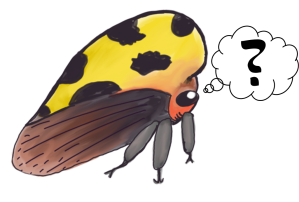@SciBugs @Stylopidae what is a lady bug called that is half brown and half red? pic.twitter.com/E7JrP8qnzb
— Mendel’s Firsties (@bridget_mendel) April 21, 2015
@UKLadybirds How unusual are half-and-half ladybirds like this? It looks pretty unusual to me but was just wondering https://t.co/Z9rGBOZT6X — Andrea Davidson (@andrea_davidson) May 5, 2015
We’ve gotten a lot of questions about ladybugs which are half yellow-brown and half red. This isn’t a normal situation by any means, and it only happens in maybe one in every ten-thousand beetles based on what I’ve seen while raising ladybirds. It’s an example of a deformity, and an interesting one at that.
So what’s going on here?
There’s two things which could be happening in these pictures, and I can’t say with certainty which one of the two choices it is. However based on what’s known about ladybug coloration, I believe this is an injury which happened while the beetle was squeezing out of it’s pupa.
Nancy has written a little bit on what makes bug colors, but this type of color requires us to explain how these colors get there in the first place.
So let’s explore insect colors!
This sort of question is really neat because it plays right into my interests as a molecular biologist. I tend to look at bugs as a collection of little machines, called enzymes. As bugs grow, these machines are turned on and off at certain times in certain places. It’s not unlike watching a building get built.
Watching a house get built isn’t much different than watching bugs get built. There’s machines which lay the foundation, there’s machines which build the structures, and there’s machines which paint the house. The study of the machines which build the bugs is called developmental biology.
We’re interested in which machines paint the ladybugs. Unfortunately, there’s not a lot that’s known about how beetles paint themselves. Most of the information that’s out there focuses on butterflies. That’s okay, though, because we can describe how butterflies work and make some educated guesses about how this all works in ladybugs.
How do bugs paint themselves?
Bugs are a collection of machines which do different things depending on where they are. It’s easier to use machinery that’s already there than it is to evolve whole new systems. In Nancy’s post about the Malachite butterfly, she explained how the green color was made by the butterfly recycling the machines which grabs fat when the bug eats. New stuff gets built by reusing old parts.

This fossil fly, called Eohelea petrunkevitchi, is a great example which shows how these systems evolved. The fly has an eye on it’s wing (white arrow), which probably wasn’t functional. It likely played a role in telling other flies whether it was the same type of bug or not.
The machines which paint ladybug wings is also probably recycled, but nobody knows exactly what they are. Butterflies are the best studied system, and the red in their wings comes from the stuff which makes their eyes dark. A lot of the machines which help build the eyes also helps make them red. These machines come in sets called pathways. The main switch in this pathway is an eye gene called optix, which tells the paintmaking machines where to go.
The names of the stuff in the pathway isn’t important, so I won’t be making a big deal of names. What is important is that this stuff acts like an assembly line. One machine gets the parts, and turns it into something different. The thing the first machine made gets passed on to the next machine, which turns it into something else and passes it onto a third machine. This might continue three or four times until a red paint gets made.
Hypothesis 1: The ladybug got hurt while squeezing out of it’s pupa
We can tell a lot about what’s going on by looking at these pictures, and watching a ladybug after it gets out of the pupa. The part of the video we’re interested in begins at 1:45, so feel free to skip to that point when watching the video.
When the ladybug gets out of it’s pupa, it’s colors aren’t fully formed. These colors form within a few hours to a few days. First, they’re a spotless pale yellow. Then, their spots develop and the rest of the wings slowly turn orange or red. This is what that process of stuff getting passed around the assembly line looks like from high above, the color of the wings slowly changing.
Ladybug blood is a pale yellow, so the first color you see is likely blood. In butterflies, the precursors get made shortly after the butterfly emerges from the pupa. So if there’s an injury to the wing which blocks the blood supply in this narrow window, the machines won’t get their raw materials. If the machines don’t get the materials they need to make red paint, the wings won’t turn red.
Hypothesis 2: The ladybug is split down the middle.
I believe this one to be less likely for a number of reasons too complicated to fully discuss here, but there’s another possibility: the ladybug is a mix of slightly different machines.
Bugs develop differently than people, but in people there’s a genetic condition called heterochromatism which is a really fancy way of saying that a person has two different eye colors. Actress Mila Kunis has this condition.
 The directions for the machines that make the paint in ladybugs are stored in DNA segments called genes. Some machines, like optix, tell the ladybug what to build and where to build it. The ladybug gets two copies of the directions (called alleles), so there’s a backup if one machine’s directions are broken.
The directions for the machines that make the paint in ladybugs are stored in DNA segments called genes. Some machines, like optix, tell the ladybug what to build and where to build it. The ladybug gets two copies of the directions (called alleles), so there’s a backup if one machine’s directions are broken.
Sometimes, while the bug is being built, the directions for both copies of the machines end up being broken. This is called a mutation. If the mutation happens in the right time and the right place, the ladybug won’t look the same on each side.
However, I think this is less likely than the first one I discussed. The reason I think this is less likely is because the eyes of the ladybugs our twitter followers sent us are dark. There are mutations in ladybugs which cause the wings to be yellow. In most, but not all of these mutations, the yellow ladybugs also have white eyes.
The eyes on both of these ladybugs are black, so I believe this to be an injury. However, there’s no way to know without extensive genetic testing…and this is really expensive. Even then, I wouldn’t be able to do it without knowing which genes in the ladybugs make color.
The Bottom Line

Mutant ladybirds, Coleomegilla maculata, from a laboratory population maintained at the USDA. The insects on the left are normal, while the insects on the right have defective pigmentation.
The above discussion is largely an educated guess, because there’s not a lot that’s known about how ladybugs make colors. My guess is based on what happens in butterflies, but beetles are really different than butterflies and it’s likely the process is completely different in beetles.
One really important question which needs to be answered about ladybug beetle coloration is what ladybug paint is made of. Butterfly wings are painted red by chemicals called ommachromes, but some researchers believe that ladybug wings are painted red or orange by another group of chemicals called carotenoids. Carotenoids are the chemicals which make carrots orange, and make tree leaves turn red in the fall.
This creates more questions than answers, however. Not a lot of animals produce carotenoids, but ladybugs just so happen to eat aphids…which are one of the few animals which make this kind of paint. Carotenoids aren’t known to darken bug eyes, which doesn’t explain why yellow ladybugs have white eyes.
So, as I said…this is an educated guess and I don’t know for sure. However, we’re likely seeing either an injury or a developmental defect. My money is on an injury.


Maybe the ladybird had flown home and got scorched in the fire?
LikeLike
Interesting post! Is there a scientific name for this type of discolouration? Someone suggested bilateral dichroism – would you agree? Thanks in advance.
LikeLike